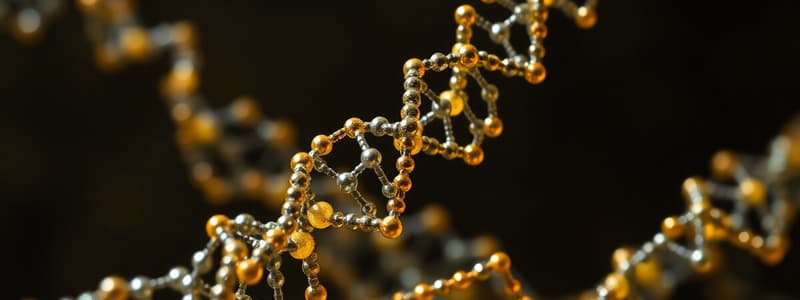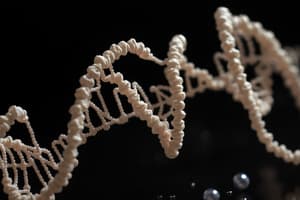Podcast
Questions and Answers
What is the primary function of the lock-key system in the DNA cubic box lid?
What is the primary function of the lock-key system in the DNA cubic box lid?
- To enhance the structural integrity of the box
- To control the opening of the lid (correct)
- To prevent the box from being closed
- To connect the sheets of the box
Tetrahedra are constructed using five strands of DNA.
Tetrahedra are constructed using five strands of DNA.
False (B)
What structural feature connects the neighboring faces in the DNA cubic box?
What structural feature connects the neighboring faces in the DNA cubic box?
hinge strands
The DNA cubic box was designed by _______ et al.
The DNA cubic box was designed by _______ et al.
Match the following concepts with their descriptions:
Match the following concepts with their descriptions:
What is a Holliday junction (HJ) in DNA nanotechnology?
What is a Holliday junction (HJ) in DNA nanotechnology?
A double crossover (DX) requires two exchanges between two double helices.
A double crossover (DX) requires two exchanges between two double helices.
What are the three types of key motifs that involve exchanges between helices?
What are the three types of key motifs that involve exchanges between helices?
In DNA structure, the ___ refers to strands that can interact cohesively due to sticky ends.
In DNA structure, the ___ refers to strands that can interact cohesively due to sticky ends.
What type of structure can be assembled using branched DNA molecules with sticky ends?
What type of structure can be assembled using branched DNA molecules with sticky ends?
Paranemic crossover (PX) involves exchanges between strands of opposite polarity.
Paranemic crossover (PX) involves exchanges between strands of opposite polarity.
Match the following DNA structures with their descriptions:
Match the following DNA structures with their descriptions:
A two-dimensional DNA array can be formed from the self-assembly of ___ triangle tiles.
A two-dimensional DNA array can be formed from the self-assembly of ___ triangle tiles.
What is the role of 'staple' DNA strands in DNA origami structures?
What is the role of 'staple' DNA strands in DNA origami structures?
DNA nanotubes serve as structural components within cells.
DNA nanotubes serve as structural components within cells.
What is the scaffold material used in the DNA origami structures described?
What is the scaffold material used in the DNA origami structures described?
A family of rigid three-dimensional DNA _________ was constructed with edge lengths of 10 nm.
A family of rigid three-dimensional DNA _________ was constructed with edge lengths of 10 nm.
Match the following DNA structures with their descriptions:
Match the following DNA structures with their descriptions:
What kind of symmetry does the cross-shaped tile structure in the DNA lattice possess?
What kind of symmetry does the cross-shaped tile structure in the DNA lattice possess?
The staple DNA strands used in DNA origami have identical sequences.
The staple DNA strands used in DNA origami have identical sequences.
What technique was used to fabricate arbitrary two-dimensional shapes in DNA origami?
What technique was used to fabricate arbitrary two-dimensional shapes in DNA origami?
Study Notes
Self-Assembly of DNA Nanostructures
- DNA nanostructures are structures built from DNA molecules.
- These structures can be one-dimensional (1D), two-dimensional (2D), or three-dimensional (3D).
Key Motifs in Structural DNA Nanotechnology
- Holliday Junction (HJ): A four-arm junction formed by a single reciprocal exchange between two double helices.
- Double Crossover (DX): A molecule resulting from a double exchange between two double helices.
- Triple Crossover (TX): A molecule resulting from two successive double reciprocal exchanges between three double helices.
- Paranemic Crossover (PX): A molecule where two double helices exchange strands at every possible point of proximity.
- JX2 Molecule: A molecule that lacks two of the crossovers of the PX molecule.
Two-Dimensional DNA Array Structures
-
DNA Lattice Structures: Composed of repeating tiles that self-assemble into arrays.
- Triangles: Self-assemble into 2D arrays.
- Hexagons: Formed from six equilateral triangle complexes.
- Cross-shaped tiles: Self-assemble into fixed-size arrays.
- Three-pointed Star Motifs: Self-assemble into hexagonal lattices.
-
DNA Origami Structures:
- Constructed using a long, single-stranded DNA scaffold.
- Short "staple" strands bind to the scaffold, folding it into a desired shape.
- Allows for the creation of complex 2D shapes, including words and images.
-
DNA Nanotube Structures:
- Promise to be useful for biomimicry, particularly in the reproduction of microtubules.
- DAE-E tiles, containing five DNA strands, self-assemble into rigid rectangular cores.
Three-Dimensional DNA Nanostructures
-
Tetrahedra:
- Rigid 3D structures with edge lengths of 10 nm.
- Self-assemble quickly and can be connected by programmable DNA linkers.
-
DNA Cubic Box with a Controllable Lid:
- Constructed using an M13 strand divided into six sections, with each section forming a sheet (face).
- Faces are connected by "hinge" strands.
- The lid is functionalized with a lock-key system.
- Its opening can be controlled and read out by FRET switches.
-
Shih's Group Strategy:
- 3D shapes are composed of multiple "stacked" DNA origami sheets.
- This approach enables the building of custom 3D shapes.
Studying That Suits You
Use AI to generate personalized quizzes and flashcards to suit your learning preferences.
Related Documents
Description
Explore the fascinating world of DNA nanostructures, including their self-assembly into one-dimensional, two-dimensional, and three-dimensional forms. This quiz covers key motifs in structural DNA nanotechnology, such as Holliday Junctions and Double Crossovers. Test your knowledge on the innovative applications of DNA lattice structures.




